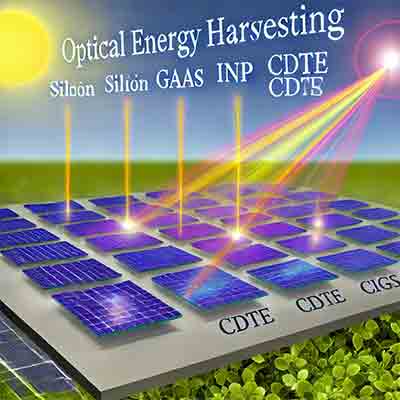Our group is focusing on the harvesting of solar energy underwater. We are looking for the supply of photovoltaic cells having a bandgap in the range of 1.8eV to 2.3eV in order to optimize solar energy. Preferably looking for Indium Gallium Phosphide, Gallium Arsenide. We would like to know if you have a product which can suffice our need? We would also like if we could get a quotation for same with delivery time.
Substrates for Optical Energy Harvesting
Substrates Used to Harvest Solar Energy Underwater
A graduate student urrently research materials for energy harvesting requested the following quote:
Reference #257878 for specs and pricing.
Get Your Quote FAST! Or, Buy Online and Start Researching Today!
Harvest The Sun's Energy With Silicon, Gallium, Arsenide, Indium Phosphide, Cadmium Telluride Wafers
Optical Energy Harvesting with solar panels made from various materials, showcasing the conversion of sunlight into electrical energy. The background emphasizes the renewable energy aspect with a bright sun, clear sky, and greenery.

What Substrates Are Used to Fabricate Optical Energy Harvesting?
Optical energy harvesting involves converting light energy into electrical energy using various optical materials and devices, such as photovoltaic cells and photodetectors. The substrates used in the fabrication of these devices are selected based on their optical properties, electrical characteristics, thermal stability, and ease of integration with other materials. Common substrates for optical energy harvesting include:
-
Silicon (Si): The most widely used substrate in photovoltaic cells due to its abundance, well-understood fabrication processes, and good electrical properties. Silicon wafers are used in both monocrystalline and polycrystalline forms for solar cells.
-
Gallium Arsenide (GaAs): Known for its high efficiency in converting light to electricity, GaAs is used in high-performance photovoltaic cells, especially in space applications and concentrated photovoltaics. GaAs substrates offer high electron mobility and direct bandgap properties.
-
Indium Phosphide (InP): Similar to GaAs, InP is used in high-efficiency photovoltaic cells and photodetectors. InP substrates are particularly suitable for applications requiring high-speed and infrared light absorption.
-
Cadmium Telluride (CdTe): Used in thin-film solar cells, CdTe substrates offer a cost-effective solution for large-scale energy harvesting. CdTe cells are known for their high efficiency and low production costs.
-
Copper Indium Gallium Selenide (CIGS): Another material used in thin-film solar cells, CIGS substrates provide high efficiency and flexibility. CIGS cells are suitable for a wide range of applications, including flexible and portable solar panels.
-
Perovskite Materials: A new class of materials used in high-efficiency solar cells, perovskites can be deposited on various substrates, including glass, silicon, and flexible polymers. Perovskite solar cells are gaining popularity due to their high efficiency and potential for low-cost production.
-
Glass: Various types of glass substrates, such as borosilicate glass, are used for their optical clarity, chemical resistance, and thermal stability. Glass is commonly used as a substrate for thin-film solar cells and other optical energy harvesting devices.
-
Polymers: Flexible and lightweight polymer substrates, such as polyethylene terephthalate (PET) and polyimide, are used for flexible solar cells and portable energy harvesting devices. Polymers offer ease of processing and mechanical flexibility.
-
Organic Materials: Organic photovoltaic (OPV) cells use organic compounds as the active layer, and these materials can be deposited on flexible substrates like PET or polyimide. OPV cells offer potential for low-cost, lightweight, and flexible energy harvesting solutions.
-
Metal Foils: Metal substrates, such as stainless steel or aluminum foils, are used in flexible and rugged photovoltaic cells. Metal foils provide mechanical strength and can be used in environments where durability is essential.
Each of these substrates provides unique benefits depending on the specific requirements of the optical energy harvesting application, such as efficiency, flexibility, cost, and durability. The choice of substrate is crucial in determining the overall performance and suitability of the energy harvesting device.
